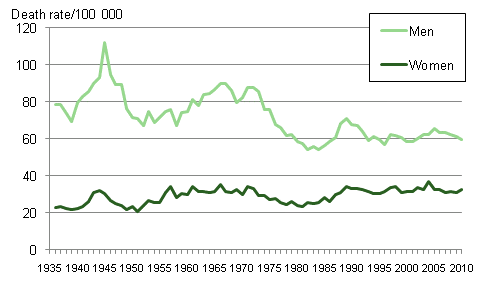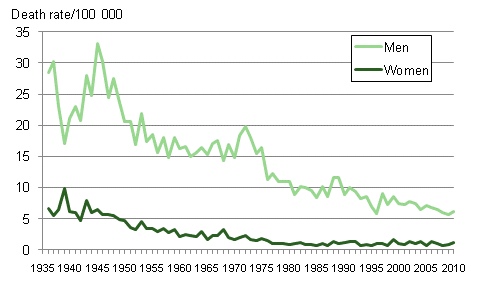4. Accident mortality in 1936 to 2010
Fatal accidents include such as fatal traffic accidents, fatal falls and stumbles, drownings, fatal fires and alcohol and drug poisonings. Accident mortality has been from 1936 to 2010 considerably higher for men than for women, although the highs and lows have occurred at the same time for both genders. Accident mortality among young people is more general than average for the whole population.
Figure 10. Accident mortality in 1936 to 2010 per 100,000 persons of the mean population

There were many fatal accidents during the war years regardless of the fact that the mortality rate directly caused by the war is not included in the figures presented. For example, poisoning deaths increased. The statistics for 1941 to 1945 indicate that this was the result of "on the one hand, carbon monoxide poisonings caused by charcoal and wood-gas generator cars, on the other hand, use of wood spirit and other poisonous liquids for intoxicating purposes". Accident mortality was at its highest immediately after the war in 1945. The number of deaths by drowning and from fractures and contusions was particularly high and fatal accidents of men especially increased. One reason is assumed to be the traumatic experiences of men returning from the war. Post-traumatic stress can have caused risen accident-proneness and increased use of alcohol, which could also have raised the number of accidents. However, there are no extensive research data on the matter in Finland.
Accident mortality was again slightly higher in the 1960s, but started to fall in the late 1970s. In the 1960s and early 1970s, 40 per cent of fatal accidents were traffic accidents. The number of fatal accidents started to grow again in 1986, specifically due to the growing number of fatal traffic accidents especially in younger age groups. Accident mortality has remained more or less unchanged since the recession years of the 1990s. More information on persons killed in road traffic accidents from 1931 to 2006 is available in the time series published on Statistics Finland's web pages in 2007.
A total of 2,856 persons died in accidents in 2010, of whom 1,869 were men and 987 women. Accidents caused around six per cent of all deaths. In 2010 the most common accident leading to death among both men and women was a stumble or fall, which caused the death of 1,185 persons. Over one third of men's fatal accidents and over one half of women's were caused by stumbles and falls. In 2010, 299 persons died in transportation accidents, three fourths of whom were men. Among men more than one in ten (12.0%) fatal accidents took place in traffic (transportation), among women slightly fewer (7.6% of women's fatal accidents).
Finland's accident mortality is the highest among EU countries after Latvia, Estonia and Lithuania. Particularly fatal accidents at home and leisure are in Finland higher relative to the population size than elsewhere in Western Europe. However, there are often problems involved in comparing national statistics, which are due to differences in classification practices and establishment of causes of death. Not all countries record fatal accidents as accurately as Finland, which may appear as lower mortality rates for those countries. According to the latest data, the share of people killed in traffic in Finland is the lowest in the EU, five persons per 100,000 population. Traffic mortality is of the same size or lower in Sweden, Norway and Germany, for example.
Contribution of alcohol, drugs and intoxication to fatal accidents
In 2010, 20 per cent, or 442 persons (excl. actual alcohol poisonings) of those dying accidentally were intoxicated. In fatal accidents intoxication means that the doctor signing the death certificate judged that alcohol had contributed to the death. The figures exclude alcohol and drug poisonings where alcohol or drugs have not directly caused the death. In heat of sauna deaths 28 out of 45 persons were intoxicated at death. In fires and among those dying of cold less than one half were intoxicated, in drowning accidents over one half. Slightly more than every fifth road traffic fatality occurred while intoxicated.
Drownings and deaths in water traffic accidents in 1936 to 2010
Drownings and water traffic accidents have been falling from the 1930s to this day. 1) As said earlier, in the war years and right after it, fatal accidents increased and the number of drownings was particularly high in 1945. The number of drownings has been around 200 in recent years. In the 1930s and 1940s, the number varied between 500 and 700.
Figure 11. Drownings and water traffic accidents, mortality in 1936 to 2010 per 100,000 persons of the mean population

In Finland alcohol is very often connected to drowning accidents. Slightly over one half of drowning cases occur while intoxicated, even more in summer months.
1) The figure includes water traffic accidents in addition to drownings (due to changed classifications). Water traffic accidents include both drownings and other deaths in water traffic. However, most of water traffic accidents are drownings.
Source: Causes of death, Statistics Finland
Inquiries: Marja-Liisa Helminen (09) 1734 3273, Helena Korpi (09) 1734 3605, Irmeli Penttil� (09) 1734 3253, kuolemansyyt@stat.fi
Director in charge: Jari Tarkoma
Updated 16.12.2011
Official Statistics of Finland (OSF):
Causes of death [e-publication].
ISSN=1799-5078. 2010,
4. Accident mortality in 1936 to 2010
. Helsinki: Statistics Finland [referred: 27.12.2025].
Access method: http://stat.fi/til/ksyyt/2010/ksyyt_2010_2011-12-16_kat_005_en.html

